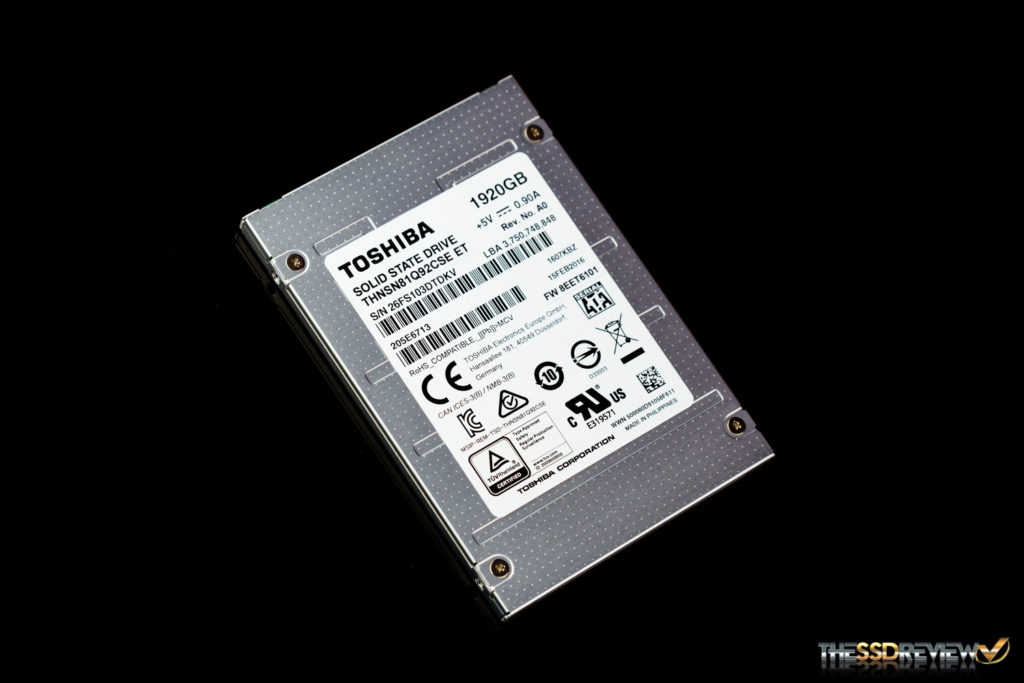SATA SSDs are all the rage in data centers. Unlike their PCIe bothers, these SATA SSDs don’t often need to have high endurance figures and lightning fast IOPS performance. Instead, they typically just need to be cheap, reliable, and what is becoming more important lately, high capacity. With 1-3 DWPD ratings, they are the perfect medium for read intensive applications in web and file servers that do media streaming, video on demand, and warm data storage. Likewise, they need to have consistent performance and low operating power. This is where Toshiba’s latest enterprise grade SATA SSDs come in to play.
The Toshiba HK4R is a high quality, power-efficient, and cost effective SATA SSD designed for these read intensive workloads. It boasts all the enterprise features you can ask for, such as end-to-end data protection and SED options, and it offers some decent performance numbers with its state of the art 15nm MLC NAND flash memory. But, just how well does it perform in this very competitive landscape? Read on as we dive into our review of the 1920GB Toshiba HK4R!
SPECIFICATIONS AND AVAILABILITY
The Toshiba HK4R is a SATA 6Gb/s 2.5″ 7mm SSD. It is currently available in capacities ranging from 120GB to 1920GB. Utilizing Toshiba’s next gen 15nm MLC NAND and Toshiba TC58 controller, sequential performance is rated for up to 524MB/s read and 503MB/s write while 4K random performance is rated for up to 75K IOPS read and 14K IOPS write.
In terms of reliability the MTTF or Mean Time to Failure rating is 2 million hours and it has a AFR rating of 0.44%. Power consumption is rated for 4.5W active/1.2W idle, which is fairly average for a SATA SSD in its class. The operating temperature’s range is 0-55C and it is covered by a 5-year warranty. In terms of endurance, the HK4R is rated for 1 DRPD, or up to 3520TBW for the 1.92TB model we are testing today.
| Toshiba HK4R | |||||
| Capacity | 120GB | 240GB | 480GB | 960GB | 1920GB |
| Sequential Read (MB/s) | 524 | 524 | 524 | 524 | 524 |
| Sequential Write (MB/s) | 126 | 283 | 503 | 503 | 503 |
| 4K Random Read (IOPS) | 75K | 75K | 75K | 75K | 75K |
| 4K Random Write (IOPS) | 4K | 10K | 12K | 14K | 14K |
| Mixed IOPS (65/35 R/W, random 4K) | – | 22K | 35K | 35K | 35K |
| Endurance (DWPD)/TBW | – | 1/440 | 1/880 | 1/1760 | 1/3520 |
In terms of enterprise class features, nothing is missing. The HK4 Series SSDs are Toshiba’s first SATA SSDs with optional Trusted Computing Group (TCG) enterprise encryption support. They also feature Toshiba’s proprietary QSBC (Quadruple Swing-By Code) error correction technology. It is a highly efficient error correction code (ECC) that help prevent data corruption caused by NAND flash memory wear, which improves reliability and extends drive life. It has end-to-end data protection and PLP (power loss protection), which guarantees data integrity during power loss and it supports hot-plugging/OS-aware hot removal.
A CLOSER LOOK
The HK4R comes in a standard 2.5mm 7mm form factor in a light alloy case and will weigh in at up to 60g max. Our 1920GB review sample weighed in at 53g. It utilizes small thermal pads placed on each component package to help dissipate heat into the case and even cool the bottom of the PCB where there are no components.
Overall, we can see there are 8 NAND packages on a single side of the PCB. The NAND being utilized is Toshiba’s 15nm MLC, part number TH58TFT1EFLBA8P. Each package is 256GB in capacity and the SSD formats to 1788GB within a Windows environment.
In addition, there are two 1GB DRAM packages by Micron and a single large capacitor to provide for its power loss protection.
The controller is manufactured by Toshiba, part number TC58NC9K16GSB. We have seen the TC-58 before in the consumer grade OCZ Trion 150, so it will be interesting to see what it can bring to the table with Toshiba’s MLC NAND rather than the TLC NAND we have tested with it before.
 The SSD Review The Worlds Dedicated SSD Education and Review Resource |
The SSD Review The Worlds Dedicated SSD Education and Review Resource | 

